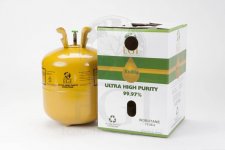balsamfirgreen
Member
Previously, I've only done open extractions with a stainless steel tube and 10oz cans. Someone gifted me a 50# tank of butane. it has an internal liquid siphon tube and a flare fitting. How can the flare fitting be be rigged to a hose that goes into a hole in the rubber stopper at the top of the extraction tube? Or am I stuck with 5 gallons of butane I cant use unless I have a closed loop system?




